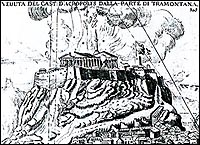The sculptures of the Parthenon are closely connected with the form and significance of the building. Their technical detail, like their genre and subject, indicates an ensemble integrated with the architectural product. The fate of the sculptures has been that of the temple itself, during its long and tumultuous history. The building has suffered burning, bombing, conversion, and looting. There was at least one fire in antiquity, probably in the days of the Antonines. When the Parthenon was converted to a Christian church, in the 6th or 7th century A.D., the sculptures of the east pediment were taken down to help build a sanctuary apse. Though much of the decorative sculpture was pulverized when Morosini shelled the site in 1687, enough survived for us to be able to reconstruct the two pediment compositions and determine in what order the scenes on the frieze came. |
 |




